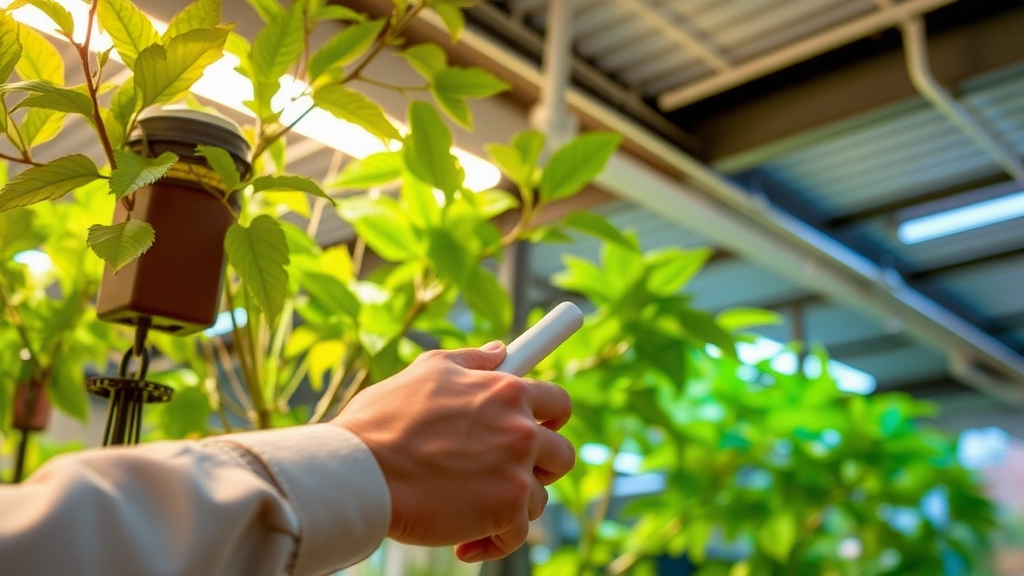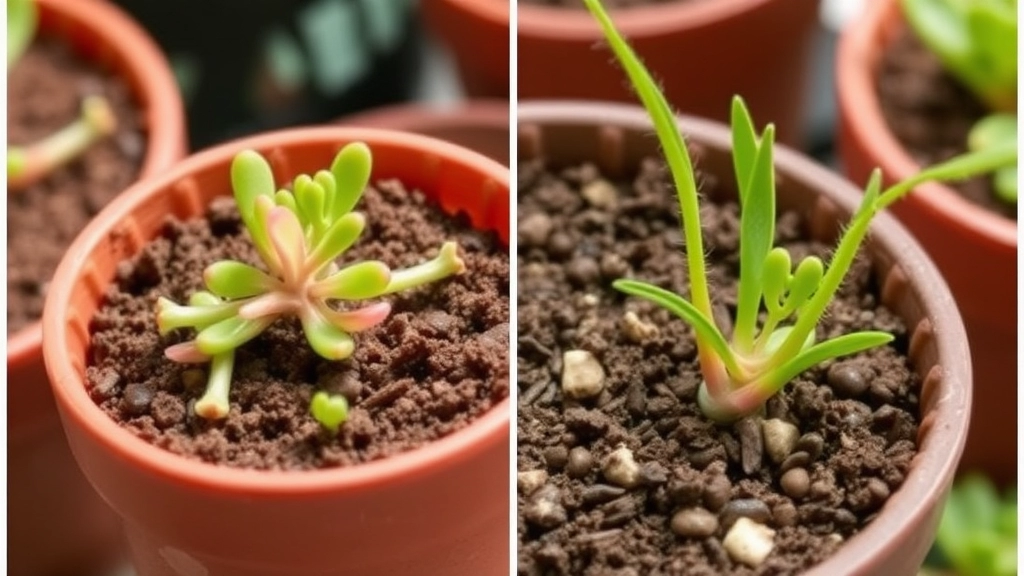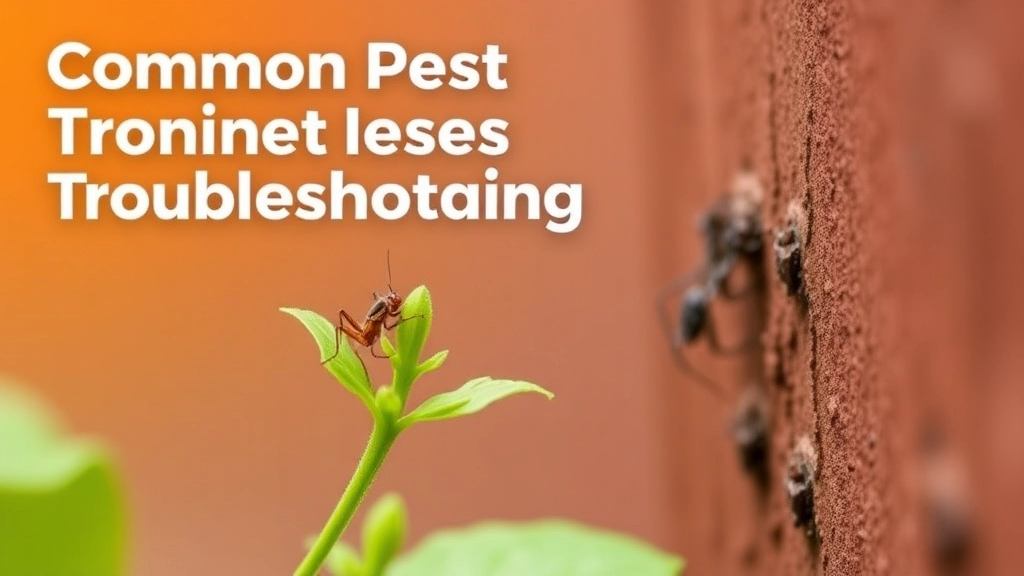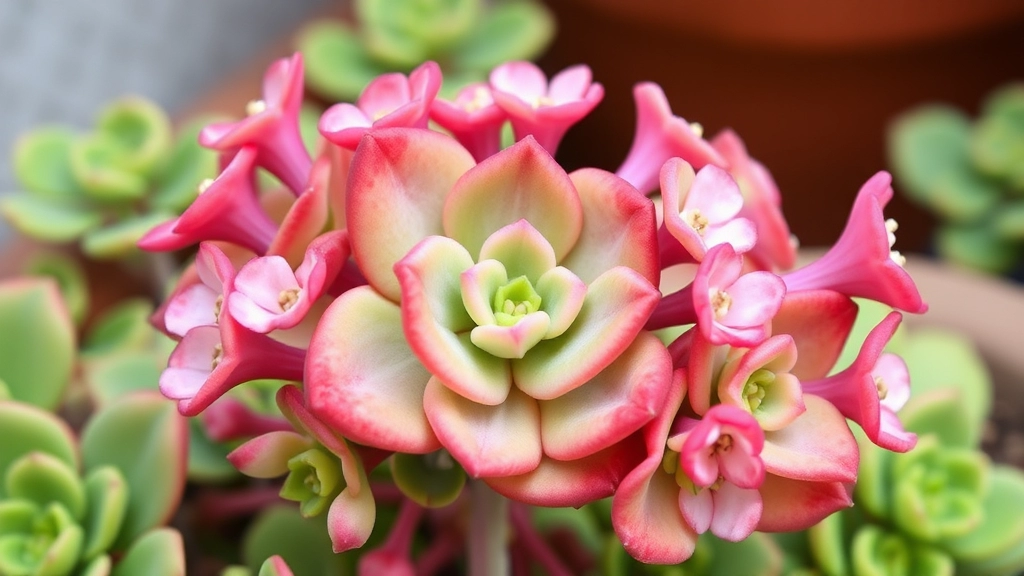How to Care for and Propagate the Mother of Thousands Kalanchoe
If you’ve ever wondered how to care for and propagate the Mother of Thousands Kalanchoe, you’re in the right place. This unique succulent, known for producing numerous plantlets along its leaves, is a favourite among gardeners and houseplant enthusiasts. Let’s dive into the best light conditions, soil mix, watering techniques, and more to keep your plant thriving.
Understanding the Needs of Your Mother of Thousands Kalanchoe
Understanding the needs of your Mother of Thousands Kalanchoe is crucial for its healthy growth. From managing temperature and humidity to mastering propagation techniques, we’ll cover everything you need to know. Whether you’re looking to prevent root rot or control its invasive nature, this guide has got you covered.
Are you struggling to find the right light conditions for your Mother of Thousands? You’re not alone. Many plant enthusiasts face the challenge of ensuring their succulents thrive under optimal lighting.
Mother of Thousands, known scientifically as *Kalanchoe daigremontiana*, flourishes in bright, indirect sunlight. Here’s how to create the ideal lighting environment for your plant:
### Key Light Requirements
– **Bright Indirect Light**: Aim for a location where your plant receives plenty of light without direct sun exposure. Too much direct sunlight can scorch the leaves.
– **Filtered Sunlight**: A south or west-facing window is perfect, but consider using sheer curtains to filter the harsh rays.
– **Supplemental Lighting**: If natural light is limited, particularly in winter months, consider using grow lights to provide the necessary brightness.
### Signs of Proper Light
– **Healthy Growth**: Leaves should be plump and vibrant green.
– **Minimal Stretching**: The plant should maintain a compact shape without long, leggy stems.
### Signs of Insufficient Light
– **Leggy Growth**: If your Mother of Thousands is stretching toward the light, it’s a sign it needs more brightness.
– **Fading Colour**: Leaves may lose their rich green hue, indicating a lack of adequate light.
For more detailed care tips, you might find the [complete guide to growing Kalanchoe Mother of Thousands](https://planthq.org/complete-guide-to-growing-kalanchoe-mother-of-thousands/) helpful. Additionally, if you’re interested in exploring other Kalanchoe varieties, check out this [succulent identification guide](https://planthq.org/kalanchoe-succulent-identification-guide-top-varieties-traits/).
Ideal Soil Mix for Healthy Growth

So, you’ve got your Mother of Thousands, and you’re wondering, “What’s the best soil mix for it to thrive?” You’re not alone! The right soil can make all the difference in keeping your plant healthy and vibrant.
What Makes the Perfect Soil Mix?
Mother of Thousands loves a well-draining soil mix. Here’s what you need to consider:
- Cactus or Succulent Mix: Start with a pre-made cactus or succulent mix. These are designed to drain well and prevent water from sitting around the roots.
- Add Some Grit: Mix in some perlite or coarse sand. This enhances drainage even further. Aim for a ratio of about 2 parts soil to 1 part perlite/sand.
- Organic Matter: Including a bit of organic matter, like compost, can provide nutrients. Just don’t overdo it—too much can retain moisture.
- pH Level: Ideally, you want a slightly acidic to neutral pH (around 6.0 to 7.0). A simple pH test kit can help you check this.
Why Is This Important?
Using the right soil mix not only supports healthy growth but also helps prevent issues like root rot. A well-draining mix ensures that excess water flows away, keeping your roots happy and dry.
Watering Techniques for Preventing Root Rot
When caring for your Mother of Thousands, one of the most pressing concerns is ensuring it receives the right amount of water. Overwatering is a common issue that can lead to root rot, a condition that can devastate your plant.
To help you navigate this challenge, here are some effective watering techniques:
- Check Soil Moisture: Before watering, always check the soil. Stick your finger about an inch into the soil. If it feels dry, it’s time to water. If it’s still moist, hold off for a few more days.
- Use Well-Draining Soil: Ensure your potting mix is well-draining. A blend of cactus mix and perlite works wonders, allowing excess water to escape and preventing soggy roots.
- Water Thoroughly, but Sparingly: When you do water, do so thoroughly. This means watering until you see it drain from the bottom of the pot. However, allow the soil to dry out completely before the next watering.
- Seasonal Adjustments: Be mindful of the seasons. In the warmer months, your Mother of Thousands may need more frequent watering, while in winter, it will require much less.
- Use Pots with Drainage Holes: Always choose pots that have drainage holes. This allows excess water to escape, reducing the risk of root rot.
By following these techniques, you’ll create an environment where your Mother of Thousands can thrive without the fear of root rot. For more detailed care tips, you might want to check out the Complete Guide to Kalanchoe Mother of Thousands Care. Additionally, understanding the health benefits of Kalanchoe Mother of Thousands can further enhance your plant care routine.
Managing Temperature and Humidity Needs

When caring for your Mother of Thousands, understanding its temperature and humidity requirements is crucial for optimal growth. Many plant enthusiasts worry about keeping their indoor gardens thriving, especially when it comes to temperature fluctuations and humidity levels.
Temperature Requirements:
- Ideal Range: Mother of Thousands thrives best in temperatures between 20°C to 30°C (68°F to 86°F).
- Nighttime Drops: A slight drop at night, ideally around 15°C to 18°C (59°F to 65°F), can be beneficial.
- Avoid Extremes: Keep your plant away from cold drafts or heat sources like radiators, as sudden temperature changes can stress the plant.
Humidity Levels:
- Moderate Humidity: This succulent prefers moderate humidity levels, around 40% to 60%.
- Dry Environments: While it can tolerate lower humidity, excessively dry conditions can lead to stress and poor growth.
- Misting: If your home is particularly dry, consider lightly misting the leaves occasionally. However, avoid overdoing it to prevent rot.
Tips for Managing Temperature and Humidity:
- Placement: Position your Mother of Thousands in a spot that receives bright, indirect sunlight, away from drafts.
- Thermometers and Hygrometers: Use tools to monitor temperature and humidity levels for better control.
- Humidity Trays: If humidity is low, place a tray of water with pebbles under the pot to increase moisture in the air around the plant.
Fertilizing Tips for Maximum Growth
When nurturing your Mother of Thousands, you might find yourself wondering how to provide the right nutrients for optimal growth.
Understanding Fertilization Needs
Mother of Thousands thrives on a balanced diet, but too much can lead to leggy growth or even damage. Here are some straightforward tips to help you fertilize effectively:
- Choose the Right Fertilizer: Opt for a balanced, water-soluble fertilizer with an NPK ratio of 10-10-10 or similar. This ensures your plant receives essential nutrients.
- Frequency: Fertilize during the growing seasonâspring and summerâevery 4-6 weeks. In autumn and winter, reduce feeding as the plant enters dormancy.
- Dilution: Always dilute the fertilizer to half strength. This prevents root burn and encourages steady growth.
- Organic Options: If you prefer organic methods, consider using compost or a diluted liquid seaweed solution. These options provide slow-release nutrients and improve soil health.
- Signs of Nutrient Deficiency: Watch for yellowing leaves or stunted growth, which may indicate a lack of nutrients. Adjust your fertilization routine accordingly.
By following these tips, you can ensure your Mother of Thousands receives the nourishment it needs to flourish. For a more detailed guide, check out our complete guide to Kalanchoe Mother of Thousands care. Additionally, if you’re interested in expanding your succulent collection, learn how to propagate Kalanchoe Mother of Thousands easily.
How to Propagate Mother of Thousands from Plantlets

So, you’ve got your Mother of Thousands thriving, and now you’re wondering, “How can I make more of these beauties?”
Propagation is a breeze!
This plant is known for its little plantlets that sprout along the edges of its leaves. Here’s how you can easily propagate them:
Steps to Propagate:
- Choose Healthy Leaves
Look for leaves that are healthy and full of life. The more plantlets, the better! - Remove the Leaves
Gently twist or cut the leaves from the main plant. Be cautious not to damage the mother plant. - Let Them Callous
Place the leaves in a dry spot for a day or two. This allows the cut edges to callous over, reducing the risk of rot. - Prepare Your Soil
Use a well-draining soil mix. A cactus or succulent blend works wonders. - Plant the Leaves
Lay the leaves flat on the soil surface or bury the plantlets slightly. - Water Sparingly
Give them a light misting. Too much water can lead to root rot, so ease up at first. - Create a Humid Environment
Cover with a plastic bag or a clear dome to keep humidity high. Just remember to ventilate occasionally! - Wait for Roots
In a few weeks, you should see roots developing. That’s your cue to remove the cover. - Transplant
Once the plantlets have established roots, you can transplant them into individual pots.
Why Propagation is Awesome:
- Cost-effective: Why buy more when you can grow your own?
- Sharing: Gift your friends some cuttings. They’ll love you for it!
- Fun: Watching them grow is incredibly satisfying.
Pruning and Controlling Its Invasive Nature
Many plant enthusiasts find themselves grappling with the rapid growth of Mother of Thousands.
How do you manage its tendency to spread uncontrollably?
Pruning is essential for maintaining its size and preventing it from overtaking your garden or indoor space.
Here’s how to effectively prune and control this plant’s invasive nature:
Common Pests and Troubleshooting Care Issues

So, you’ve got your Mother of Thousands thriving, but now you’re faced with pesky pests or care issues. It’s a common concern for plant lovers, and trust me, you’re not alone. Let’s dive into what you might encounter and how to tackle these problems head-on.
Common Pests
-
Mealybugs
- These little white fluffy critters love to hide in the nooks and crannies of your plant.
- How to Spot: Look for cottony masses on leaves and stems.
- Solution: Wipe them off with a cotton swab dipped in rubbing alcohol.
-
Spider Mites
- Tiny and often overlooked, these pests can cause serious damage.
- How to Spot: Look for fine webbing and yellow spots on leaves.
- Solution: Increase humidity and spray with insecticidal soap.
-
Aphids
- These small green bugs can cluster on new growth.
- How to Spot: Check for sticky residue (honeydew) on leaves.
- Solution: Spray with a strong jet of water to dislodge them or use neem oil.
Troubleshooting Care Issues
Sometimes, it’s not pests but care issues that can throw a wrench in your plant’s growth. Here are some common problems and solutions:
-
Yellow Leaves: This often signals overwatering.
- Tip: Ensure your soil mix drains well and let the top inch dry out before watering again.
-
Leggy Growth: If your plant is stretching, it might be craving more light.
- Tip: Move it to a brighter spot, but avoid direct harsh sunlight.
-
Root Rot: A serious issue that can sneak up on you.
- Tip: Check for mushy roots and repot in fresh soil if necessary.
Remember, prevention is key. Regularly check your plant for signs of pests or distress, and you’ll be ahead of the game.
Repotting and Container Guidelines for Mother of Thousands
Have you ever wondered when or how to repot your Mother of Thousands?
Repotting is crucial for maintaining the health and vibrancy of this succulent.
FAQs About Mother Of Thousands Kalanchoe
What is the best soil mix for Mother of Thousands?
Mother of Thousands thrives in a well-draining soil mix. A pre-made cactus or succulent mix is ideal. Enhance drainage by mixing in perlite or coarse sand at a ratio of about 2 parts soil to 1 part perlite/sand. Including a bit of organic matter like compost can provide nutrients, but don’t overdo it, as too much can retain moisture.
What temperature range is ideal for Mother of Thousands?
Mother of Thousands prefers temperatures between 20°C to 30°C (68°F to 86°F). A slight nighttime drop to around 15°C to 18°C (59°F to 65°F) can be beneficial. Avoid placing the plant near cold drafts or heat sources like radiators to prevent sudden temperature changes.
What humidity levels are best for Mother of Thousands?
This succulent prefers moderate humidity levels, around 40% to 60%. While it can tolerate lower humidity, excessively dry conditions can lead to stress and poor growth. Consider lightly misting the leaves occasionally if your home is particularly dry, but avoid overdoing it to prevent rot.
How do I propagate Mother of Thousands?
Propagation is straightforward! Remove healthy leaves with plantlets from the main plant, let them callous for a day or two, and then plant them in a well-draining soil mix. Water sparingly and create a humid environment by covering with a plastic bag or clear dome. In a few weeks, roots should develop, and you can transplant the plantlets into individual pots.
What are common pests that affect Mother of Thousands?
Common pests include:
- Mealybugs: Look for cottony masses on leaves and stems. Wipe them off with a cotton swab dipped in rubbing alcohol.
- Spider Mites: Look for fine webbing and yellow spots on leaves. Increase humidity and spray with insecticidal soap.
- Aphids: Check for sticky residue (honeydew) on leaves. Spray with a strong jet of water to dislodge them or use neem oil.
How do I troubleshoot care issues with Mother of Thousands?
Common care issues include:
- Yellow Leaves: Often a sign of overwatering. Ensure your soil mix drains well and let the top inch dry out before watering again.
- Leggy Growth: Indicates the plant needs more light. Move it to a brighter spot, but avoid direct harsh sunlight.
- Root Rot: Check for mushy roots and repot in fresh soil if necessary. Ensure good drainage to prevent this issue.
Regularly check your plant for signs of pests or distress to stay ahead of potential problems.
References
-
Mother of Thousands Plant Care
-
Mother of Thousands Plant Profile
-
Mother of Thousands: Plant Care & Growing Guide
